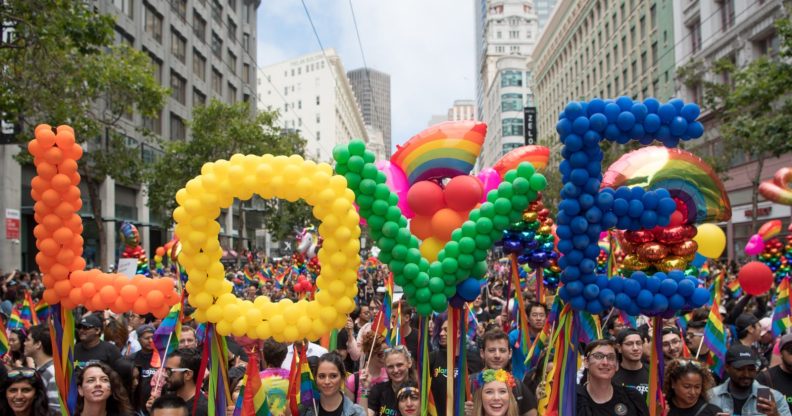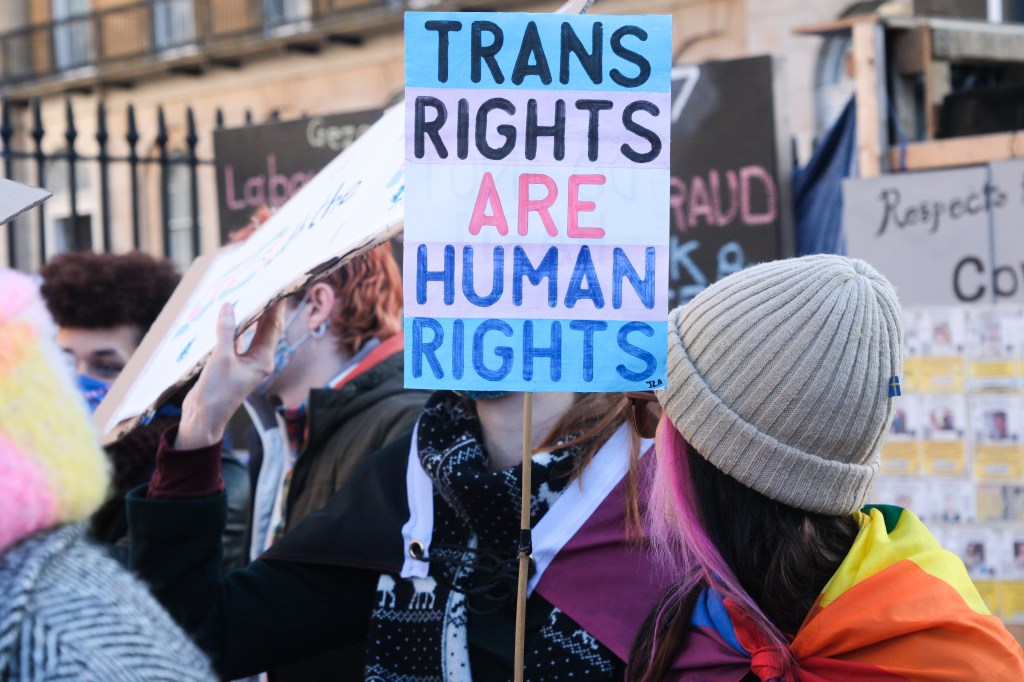What does LGBTQIA stand for? The inclusive term which includes questioning, intersex and asexual and allied people

People participate in the San Francisco Pride parade in San Francisco, California on June 25, 2017. / AFP PHOTO / Josh Edelson (Photo credit should read JOSH EDELSON/AFP/Getty Images)
LGBTQIA is the inclusive queer term which stands for lesbian, gay, bisexual, transgender, queer and/or questioning, intersex and asexual and/or allies.
While terms like this attempt to acknowledge many different groups, it’s worth noting that the LGBTQIA community is arguably not one group, but rather it is made up of many separate subsects not all in agreement on all terminology.
LGBTQIA refers to specific parts of the community, while sometimes subsects are grouped under the umbrella term “plus” in the acronym LGBTQ+.
This represents sexual identities other than lesbian, gay, bisexual, transgender and queer or questioning, including pansexual, asexual and omnisexual.
For more information on the term LGBTQ+ – which is seen by many as an accepted and inclusive way to refer to the queer community – read PinkNews’ comprehensive explainer.
It is good practice to become as well-versed as possible at understanding all subsects of sexuality and gender, so you are prepared socially for interacting with people who identify as lesbian, gay, bisexual, transgender, or as something other than these.
So, with this is mind, what about LGBTQIA?
While the first three letters in this term (LGB) focus on sexual identity – lesbian, gay, and bisexual – T, which stands for transgender, refers to an individuals’ gender identity.
Transgender refers to a person whose gender identity is different from the sex stated on their birth certificate.
For many this can mean going through gender reassignment – through hormones or surgery – but for many others this means living and identifying in a gender neutral way, preferring pronouns such as ‘they’, ‘them’ and ‘theirs’.
This brings us to Q, standing for queer and/or questioning.
According to Stonewall, queer is listed as having once been used as “a derogatory term for LGBT individuals” – but, the charity emphasises, this is “in the past”.
“The term has now been reclaimed by LGBT young people in particular who don’t identify with traditional categories around gender identity and sexual orientation,” Stonewall adds.
Queer is seen by many as a catch-all inclusive term, but Stonewall also cautions that the term is “still viewed to be derogatory by some”.
The term queer is preferred by some because due to its ambiguity and how it allows individuals to side-step the more rigid boundaries associated with labels like gay, lesbian and transgender.
Q can also stand for questioning, which represents those who are still exploring their sexuality or gender identity.
I stands for intersex, which is a person “born with a reproductive or sexual anatomy that doesn’t seem to fit the typical definitions of female or male”, according to the Intersex Society of North America.
Experts believe that 0.05 to 1.7 percent of the population is born with “intersex traits,” meaning their body is not definitively male or female.
They might have chromosomes which are not XX or XY, for example, or their genitals and/or reproductive organs are not considered ‘standard’.
That brings us to A, standing for asexual and/or ally.
According to Stonewall, an asexual person (or ace) is defined as someone who does not experience sexual attraction for any gender.
That said, there is plenty of diversity among the asexual community, just how there is among all LGBT+ communities, and – of course – the straight community.
Just like everyone else, asexual individuals respond to attraction, arousal and relationships in different ways.
Some asexual people are happier on their own, while some want to form intimate romantic relationships.
Just because someone doesn’t want to have sex, they can still want and enjoy the companionship, closeness, fun, trust and all the other elements that a close partnership can bring to one’s life.

The other term that A can stand for in LGBTQIA is ally.
In this context, an ally is a person who does not identify as LGBTQIA but supports the rights and safely of those who do.
The University of Illinois‘s J. Jay Scott and Vernon Wall say:
“Being an ally with lesbian, gay, bisexual, transgender, queer, intersex, and asexual (LGBTQIA) individuals is the process of working to develop individual attitudes, institutions, and culture in which LGBTQIA people feel they are valued.
“This work is motivated by an enlightened self-interest to end homophobia, biphobia, transphobia, heterosexism, and cisgenderism.
“An ally is a person who works both to facilitate the development of all students around issues of sexual orientation, gender identity, and gender expression and to improve the experience of LGBTQIA people.
“Allies can identify as lesbian, gay, bisexual, transgender, cisgender, intersex, queer, questioning, or heterosexual.”
Making yourself familiar with all the parts of terms like “LGTBQIA” is important, not just for yourself but for society.
GLAAD, or the Gay & Lesbian Alliance Against Defamation, has explained why it is important for society to use appropriate language: “The right words can help open people’s hearts and minds, while others can create distance or confusion.”
The organisation has also explained why this terminology is organic and continually being added to and adapting to the communities it serves:
“Coverage of LGBTQ issues has moved beyond simplistic political dichotomies and toward more fully realised representations.
“Not only of the diversity of the LGBTQ community, but also of LGBTQ people’s lives, their families, and their fundamental inclusion in the fabric of… society.”

